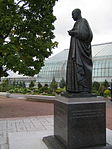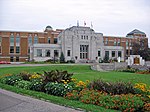Space for Life
Space for Life (French: Espace pour la vie) is a museum district in Montreal, Quebec, Canada. It brings together the city's four most prominent natural museums: the Montreal Biodome and the Rio Tinto Alcan Planetarium, situated in Montreal's Olympic Park, and the Montreal Botanical Garden and Montreal Insectarium, in the adjacent Maisonneuve Park.Space for Life was established in 2011 as a successor body to Montreal Nature Museums. It describes itself as the largest natural sciences complex in Canada. As of 2013, its executive director is Charles-Mathieu Brunelle and Montreal executive committee member Manon Gauthier is responsible for its political oversight.
Excerpt from the Wikipedia article Space for Life (License: CC BY-SA 3.0, Authors).Space for Life
Boulevard Pie-IX, Montreal Rosemont–La Petite-Patrie
Geographical coordinates (GPS) Address Nearby Places Show on map
Geographical coordinates (GPS)
| Latitude | Longitude |
|---|---|
| N 45.5557 ° | E -73.5555 ° |
Address
Jardins d'accueil
Boulevard Pie-IX
H1X 1T8 Montreal, Rosemont–La Petite-Patrie
Quebec, Canada
Open on Google Maps









